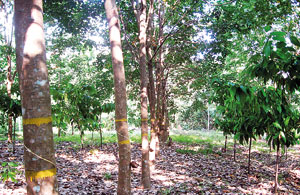Government sharply cuts rubber tax to be competitive in global market

Rubber plantation
Around 130,000 Sri Lankan rubber smallholder families will benefit from a government decision to sharply cut cess (tax) on natural rubber exports at a time when the industry has been hit by lower prices and increased cost of production.
The rubber sector provides over 300,000 direct and indirect job opportunities to Sri Lankans.
With Sri Lanka’s rubber industry depending more on eth export of natural rubber as the international prices go down and supply become tight in the local market, the government has decided to bring down the tax on export of natural rubber to Rs. 4 from Rs.15 per kg.
The Business Times learns that the Cabinet Committee on Economic Management has decided to revise cess on rubber exports after considering a cabinet memorandum submitted by the Plantation Industries Ministry.
Treasury has allocated Rs 2 billion for the subsidy while the ministry is negotiating to obtain around Rs 2.5 billion for the purpose.
Sri Lanka is going in a big way with exports to Iran and China, where there was great potential as the sanctions imposed on Iran have been lifted, a ministry official said adding that a delegation from the ministry would visit China and Iran soon to promote natural rubber exports.
A Rubber Master Plan is to be implemented soon under which a proposed 100 million-rupee worth Rubber Secretariat would not only salvage the industry which is currently facing many obstacles but also make it profitable, Plantation Industry Ministry sources said.
Local planters are urging the government to extend the cess reduction to all varieties of rubber including ribbed smoked sheet rubber, scrap crepe, all grades of technically specified rubber, centrifuged latex and specialty rubbers, instead of only crepe rubber.
The government has officially announced the cess reduction on crepe rubber but it should be extended to all grades of rubber for the benefit of the industry, a rubber industry expert and the Director of Kotagala Plantations Ranjith Peiris told the Business Times.
He noted that the cess cut on natural rubber would help the local industrialists to be competitive in the international market.
Lowering the rate would protect income of growers, as exporters now just pass the cost plus cess onto them, he said, adding that the cess reduction would also increase their earnings, which have tumbled strongly amidst a weak international market.
The price of rubber is also linked to the fluctuating price of oil which is a major factor in the production of synthetic rubber. When oil prices are high, the production costs and price of synthetic rubber also increase, which leads countries to switch to more natural rubber use.
“But at present the oil prices are low and the countries go for synthetic rubber which is cheap now whereas the natural rubber demand has gone down,” he said.
Local value added rubber manufacturers are also used to import rubber from countries like Thailand, Vietnam and Malaysia, as their prices are low, he added.
But the government’s move will change the situation for the better for local rubber producers, Mr. Peiris said pointing out those rubber producing countries especially Thailand have decided to cut production by 45 per cent to maintain a stable price to protect the industry worldwide.
He revealed that the Asian Rubber Producers Association, of which Sri Lanka is a member, has decided to have a floor price and it would help the country as growers could sell their produce at a reasonable price. Chinese traders have slowed down their purchases, a major factor in the weakening scenario
The aim of the cess scheme was to use the funds collected, through a levy on rubber exports and imported rubber products for the benefit of the industry.
However, it was credited to the consolidated fund and the previous government had used it to finance the reckless spending agenda of state authorities.
Originally it was earmarked for upgrading the industry through productivity and quality-orientated initiatives, such as replanting, expansion of new growing areas, factory development, rain-guarding and nursery work.
But the rubber producers have not received any financial reimbursement from the cess fund for work already undertaken to upgrade the industry, rubber planters said.
Rubber production declined by 10.1 per cent to 88,570 metric tons (MT) in 2015 from 98,573 MT in 2014, Central Bank data showed. The average price of natural rubber per MT has come down by 20.4 per cent to US$1,560 in 2015 from $1,960 recorded in 2014.
Under this set up smallholders slowed their tapping operations due to lower rubber prices. The unfavourable weather conditions with the high cost of production, poor management of the fields and over-aged trees contributed to the decline in production.
Sri Lanka’s rubber industry could be transformed to a $10 billion industry annually with significant value addition in the manufacturing process as well as the vast potential for future investment. With a focus on niche market specialised rubber products, the country can be a global force in rubber sector, an industry leader said.
The rubber industry in Sri Lanka was exporting just under a billion dollars annually, and unfortunately, exports have been on a downward trend since 2011. Year on year exports in 2015 were currently lower by 12.3 per cent.


